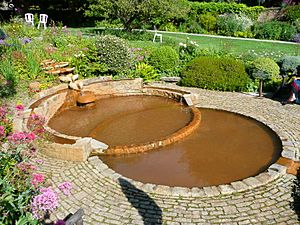Chalice Well facts for kids
The Chalice Well, also known as the Red Spring, is a famous spring located at the foot of Glastonbury Tor in Somerset, England. This natural spring and its beautiful gardens are looked after by the Chalice Well Trust, a charity started in 1959 by Wellesley Tudor Pole.
Scientists from Exeter University found in 2009 that the Chalice Well gets its water from a deep aquifer. This is like a huge underground sponge that holds water in the lower layers of the Pennard Sands.
Contents
What Makes the Chalice Well Special?
A Long History of Use
People have been using the Chalice Well for at least two thousand years! Archaeologists have found old tools and pottery pieces from different time periods near the well. These include flints from the Stone Age and pottery from the Iron Age, Roman times, and the Middle Ages. This shows how important the well has been to people for a very long time.
The Red Water and Its Powers
The spring releases about 25,000 litres of water every day. It has never stopped flowing, even during dry periods. The water looks reddish because of Iron oxide deposits. When iron in the water touches the air, it turns rusty and gives the water its unique colour.
Just like the warm springs in the nearby city of Bath, the water from the Chalice Well is believed to have special healing qualities. Many people visit hoping to feel better.
The White Spring: A Nearby Mystery
Close to the Chalice Well, there's another spring called the White Spring. Its water comes from a shallower part of the ground and is clear, not red. A building, which used to be a waterworks, now stands over this spring. It's used as a place of worship and is open to visitors at certain times.
A Place for All Faiths
The Chalice Well is a popular spot for pilgrims from many different faiths. Some people see it as a symbol of the female side of deity, with Glastonbury Tor representing the male side. It's especially popular with Neopagans who are interested in the divine feminine. However, people of all beliefs visit the well. In 2001, it was even named a World Peace Garden.
The Meaning Behind the Well Cover
Wells often appear in Welsh and Irish mythology as doorways to a spirit world. The special cover over the Chalice Well shows this idea of two worlds meeting. It was designed by Frederick Bligh Bond and given as a gift in 1919.
The cover has two circles that link together, forming a symbol called the Vesica Piscis. A spear or sword cuts through these circles. Some people think this might be a hint to Excalibur, the legendary sword of King Arthur. Many believe King Arthur is buried near Glastonbury Abbey. The design also includes leaves from the Glastonbury Thorn tree.
Legends of the Holy Grail
Many Christian legends connect the Chalice Well to the Holy Grail. Some stories say that Joseph of Arimathea placed the chalice that held Christ's blood at the Crucifixion here. This is why some believe the water turned red. Others say the red colour comes from the rusty iron nails used in the Crucifixion.
An old writer named William of Malmesbury wrote that the well's water sometimes flowed red and sometimes blue.
Similarities to Blood
Local stories say the well's water is like human blood in three ways:
- It's red.
- It seems to "clot" or thicken, like blood does. This is due to the iron content forming rust.
- It's warm. The water from deep underground is often warmer than the surface.
Even in winter, roses near the well bloom when other plants don't. The famous Glastonbury Thorn tree also blooms in the Chalice Well garden every Christmas. Legend says this tree grew from Joseph of Arimathea's staff when he put it in the ground near the well.
Events at the Well
Many events are held at the Chalice Well throughout the year. These include celebrations for the winter and summer solstices, World Peace Day, Easter, Michaelmas, and Samhain (Halloween). The well is also a very important historical site, listed as a Grade I listed building.
Visiting the Chalice Well
The Chalice Well is just outside the town of Glastonbury. It takes about 10 to 15 minutes to walk there from the town centre. You can easily visit the well as part of a walk that also includes the town centre and Glastonbury Tor.
There is no car parking at the well, except for people with disabilities. You can park your bicycle there. A bus route from Shepton Mallet to Glastonbury passes the well, but there isn't a convenient bus stop right next to it. However, the park and ride bus from Glastonbury town centre to the Tor will stop at the Chalice Well if you ask.
Even when the gardens are closed, you can still get water from the well. Some of the water flows through a pipe that comes out of the garden wall on Wellhouse Lane. Another pipe on the other side of the lane provides water from the White Spring.




